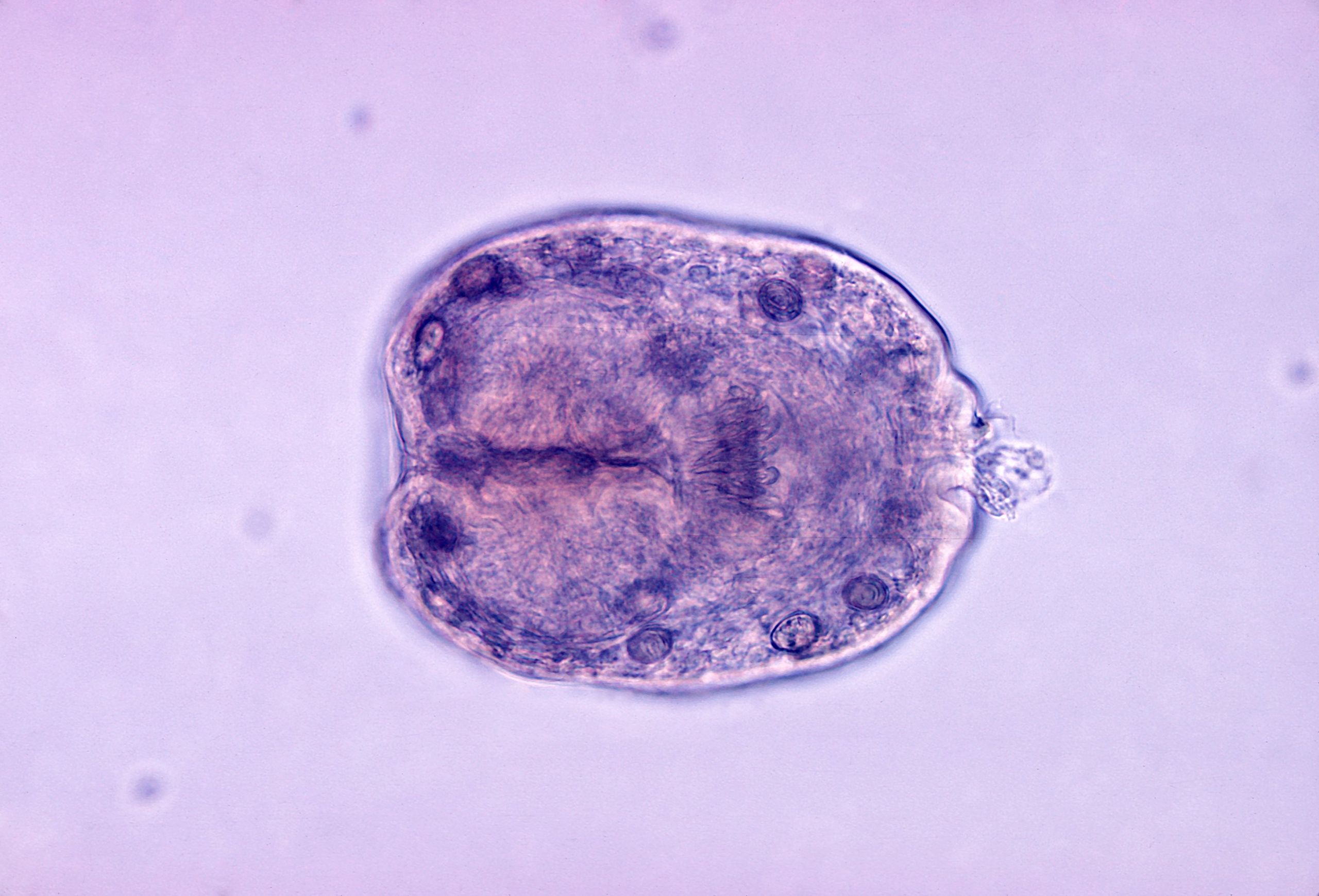Echinococcus granulosus
| Echinococcus granulosus | ||||||||||||||
|---|---|---|---|---|---|---|---|---|---|---|---|---|---|---|
 E. granulosus scolex
| ||||||||||||||
| Scientific classification | ||||||||||||||
| ||||||||||||||
| Binomial name | ||||||||||||||
| Echinococcus granulosus |
Echinococcus granulosus, also called the Hydatid worm, is a cyclophyllid cestode that parasitizes the small intestine of canids as an adult, but which has important intermediate hosts such as livestock and humans, where it causes hydatid disease. The adult tapeworm is about 5 mm long and has three proglottids ("segments") when intact. Like all cyclophyllideans, E. granulosus has four suckers on its scolex ("head"), and E. granulosus also has a rostellum with hooks.
In canids, E. granulosus causes a typical tapeworm infection, and produces eggs that are passed with the dog's feces. Intermediate hosts include herbivores such as sheep, deer, moose, kangaroos, and wallabies, and any other organism (including humans) that ingests dog feces. In the intermediate host, eggs hatch into oncosphere larvae that travel through the blood and form hydatid cysts in the host's tissues. These cysts can grow to be the size of a softball or basketball, and may contain several smaller "balloons" inside the main cyst. In the related worm Echinococcus multilocularis, the outer cyst is not present. If the outer cyst ruptures, new cysts can form at a different location in the body. Each smaller section contains several juvenile worms, and dogs may eat millions of them, resulting in very heavy infections. Hydatid cysts occur in organs like the liver, brain and lungs, not in subcutaneous tissue. Though this has never been tested experimentally, it is assumed that infected animals make easier prey for canids.
Symptoms can include liver enlargement, hooklets in sputum and possible anaphylactic shock when the immune system reacts to ruptured cysts. A cyst diagnosis with ultrasound, MRI, or immunoelectrophoresis.
File:Echinococcus Life Cycle.png Hydatid disease is treated with surgery, taking special care to leave the cyst intact so new cysts do not form, and mebendazole over a long period of time at low dosages.
The best way to keep dogs from being infected is to prevent them from eating infected offal. The best way to avoid human infection is to avoid ingesting food or other substances contaminated with dog feces.
Diagnosis in the definitive host, the dog, is difficult by ordinary microscopy as it cannot differentiate between Taenia and Echinococcus eggs. Detection of antigens in feces by ELISA is currently the best available technique. The prevalence of Echinococcus granulosus was found to be 4.5% in Bangalore, India by a study conducted by Centre of Advanced Studies in Veterinary Parasitology, Veterinary College, Hebbal, Bangalore employing this coproantigen detection technique. Newer techniques like PCR is also used to identify the parasite from DNA isolated from eggs or feces.
Treatment
Antimicrobial therapy
- Echinococcus treatment[1]
- 1.1 Echinococcus granulosus (hydatid disease) treatment[2]
- Preferred regimen: If ≥ 60 kg Albendazole 400 mg PO bid or if < 60 kg Albendazole 10-15 mg/kg/day PO bid with meals for 3-6 months
- Alternative regimen: Mebendazole 40-50mg/kg/day PO tid for 3-6 months
- Note: Percutaneous aspiration-injection-reaspiration (PAIR)- puncture and needle aspirate cyst content. Instill hypertonic saline (15–30 %) or absolute alcohol, wait 20–30 min, then re-aspirate with final irrigation. Administer Albendazole at least 4 hours before PAIR.
- Note: If surgery is needed, make sure to administer Albendazole for at least a week before the surgery, and to keep the medication for at least 4 weeks after the procedure.
References
- ↑ Ammann RW, Eckert J (1996). "Cestodes. Echinococcus". Gastroenterol Clin North Am. 25 (3): 655–89. PMID 8863045.
- ↑ Gilbert, David (2014). The Sanford guide to antimicrobial therapy 2014. Sperryville, Va: Antimicrobial Therapy. ISBN 978-1930808782.
de:Dreigliedriger Hundebandwurm it:Echinococcus granulosus ka:ექინოკოკი sk:Pásomnička pečeňová Template:WikiDoc Sources